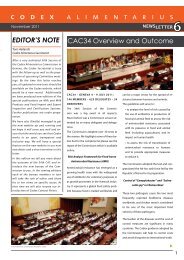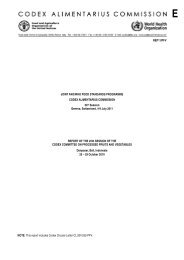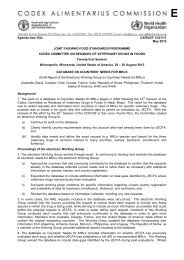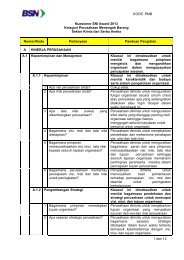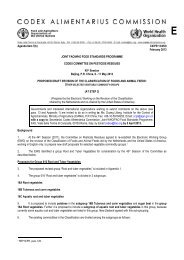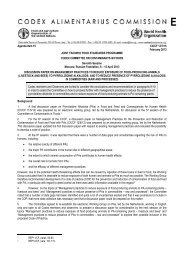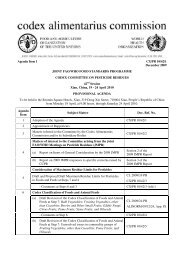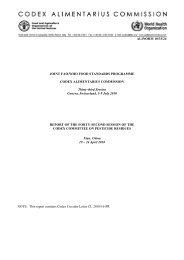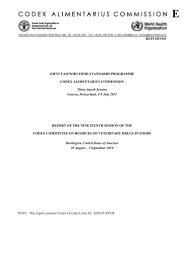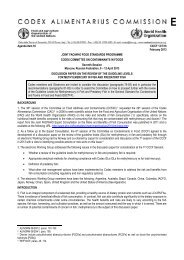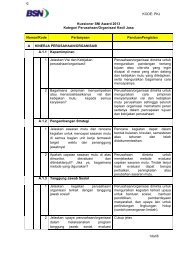alinorm 10/33/41 - CODEX Alimentarius
alinorm 10/33/41 - CODEX Alimentarius
alinorm 10/33/41 - CODEX Alimentarius
Create successful ePaper yourself
Turn your PDF publications into a flip-book with our unique Google optimized e-Paper software.
ALINORM <strong>10</strong>/<strong>33</strong>/<strong>41</strong> 865. In view of the discussion, the Committee agreed to advance the maximum levels for powdered infantformula and for foods (other than infant formula) and animal feeds at Step 5/8 and the maximum level of0.5 mg/kg for liquid infant formula for comments at Step 3.66. In relation to methods of analysis for verification of compliance with the MLs, it was agreed to request theCommittee on Methods and Sampling (CCMAS) to identify appropriate methods for the measurement ofmelamine in powdered infant formula and foods (other than infant formula) and feeds.67. It was also noted that there was a need for the development of new quantitative protein methods with ahigher discriminatory power against the presence of non-protein nitrogen sources and complimentary qualitativeauthentication techniques capable of detecting the presence of unexpected non-protein compounds in food andfeed.Status of the Proposed Draft Maximum Levels for Melamine in Food and Feed68. The Committee agreed to forward the proposed draft maximum levels for powdered infant formula andfoods (other than infant formula) and animal feed to the <strong>33</strong> rd Session of the Codex <strong>Alimentarius</strong> Commission foradoption at Step 5/8 (with omission of Steps 6 and 7) and the maximum level for liquid infant formula to Step 3for comments and consideration by the next session (Appendix IV).PROPOSED DRAFT MAXIMUM LEVELS FOR TOTAL AFLATOXINS IN BRAZIL NUTS (includingsampling plans) (Agenda Item 6) 9Maximum Levels for Brazil Nuts69. The Delegation of Brazil introduced the document outlining the main issues associated with this matter, inparticular, the establishment of different maximum levels for shelled and in-shell Brazil nuts. The Delegationstressed the need for differentiating between the shelled and in-shell Brazil nuts in view of the uniquecharacteristics of the product, i.e. a wild tree nut growing in the Amazon rain forest, therefore, complete control ofthe collection-production chain was not possible. In addition, the processing technology of in-shell Brazil nuts didnot allow the complete segregation of rotten nuts without removing the shell.70. Several delegations expressed support for Maximum Levels for Shelled, ready-to-eat Brazil nuts at<strong>10</strong> µg/kg and Shelled, destined for further processing Brazil nuts at 15 µg/kg. However, these delegationsindicated that maximum levels should be established on the basis of the intended use of the nuts (ready-to-eat orfor further processing) without distinction between shelled and in-shell nuts. This was in line with the previousdecision of the Committee in relation to maximum levels for total aflatoxins in various tree nuts (almonds,hazelnuts and pistachios) which were also traded internationally in-shell and would also ensure a consistentapproach throughout Codex in the setting of maximum levels for tree nuts. In addition, these delegations notedthat the burden of selecting good nuts should not be placed on consumers but on the producers and regulatoryinstitutions in order to guarantee the safety of the product.71. Some delegations indicated that the implementation of the revised Appendix on Additional Measures forBrazil Nuts (Code of Practice for the Prevention and Reduction of Aflatoxin Contamination in Tree Nuts) wouldalso assist in-shell Brazil nuts in complying with the maximum levels proposed for shelled Brazil nuts.72. Other delegations noted that in-shell Brazil nuts found non-compliant with the proposed maximum levelscould undergo further treatment, i.e. shelling and sorting including other alternative processing, so that the Brazilnut kernels could meet the maximum levels thereby limiting the economic damage resulting from noncompliance.In this regard, it was noted that the sampling plans for in-shell Brazil nuts could be revised to refer tothe kernels as opposed to the in-shell nut in order to accommodate non-compliant in-shell Brazil nuts as the ediblepart of the product was the kernel. It was also noted that the Criteria for the Establishment of Maximum Levels ofContaminants in Food and Feed <strong>10</strong> states that for contaminant purposes analysis and consequently MLs willpreferably be on the basis of the edible part of the product.73. An Observer indicated that tolerances in international marketing standards for various tree nuts tradedshelled and in-shell already incorporated tolerances for defects e.g. rotting or any other of deterioration, looseshells, shell fragments, etc. and that a similar approach should be taken for the establishment of maximum levelsfor aflatoxins in this type of products.9<strong>10</strong>CX/CF <strong>10</strong>/4/6; CX/CF <strong>10</strong>/4/6-Add.1 (comments of Argentina and Norway); CX/CF <strong>10</strong>/4/6-Add.2 (comments ofJapan); CRD 4 (comments of Kenya); CRD 5 (comments of Iran); CRD 9 (comments of the EU); CRD 14 (commentsof Bolivia); CRD 22 (comments of Ecuador).General Standard for Contaminants and Toxins in Food and Feed (<strong>CODEX</strong> STAN 193-1995).



